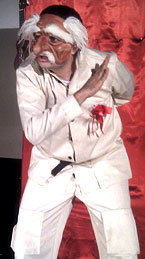I was in India not long ago directing a one-man-Commedia dell’Arte play called ”A Kela Commedia Extravaganza” with Deepal Doshi from Rangeelay Theatre Ensemble. Sitting in the audience at the opening, watching my play the similarities between renaissance Italy and India of today suddenly struck me. The conditions for the Commedia dell’Arte we played in the theatre was actually happening right outside the house, which was a luxury hotel and a slick club much like the courts that Commedia dell’Arte used to be played in .
Here are a few examples of similarities:
- Arranged marriages are still the most common, but are becoming more and more challenged, primarily in the upper parts of society.
- The urban society (where Commedia dell’Arte takes place) in India are still not segregated. There is still room for homeless and the low casts to meet and interact with the rich, the politicians and the westernized youth daily.
- Just like renaissance Italy most parts of life is lived out on the street and not at home. It is full of street sellers, food stalls, small shops open to the street… This makes the street into the perfect meeting place. A place where communion is central and where there is no place for private life.
- It is an extremely hierarchic community, both visual, in how people dress and behave, and direct, when you can see servants, porters, or guards getting beaten up by their masters on the street.
- Cheap labor makes it possible for the middle classes to buy and hire barbers, tailors, posters servants, chauffeurs, cleaners and more.
- Just like in renaissance Italy when the upper classes where leaving old medieval traditions and ideals the upper classes of India of today are searching for new ways to spend their wealth and their lives.
- Religion is an very important part in people’s daily life with all its taboos and regulations, something that prevent us from doing a lot of things on stage. For example it is not any strict taboos about four-letter words, but it is more or less impossible to anathematize someone on stage.
And there is more similarities that I can’t come up with right now.
While I was sitting there lots of old lazzi became much more understandable from a new angle, like; ”Arlecchino trying hard to carry someone’s bag”, ”the fake fortune-teller”, ”the eating of the fly” (something that i actually saw happen) and so on.
We tend to forget that the same Commedia dell’Arte masks, that now are representing parts of our inner life, at the time where caricatures of real people who actually was there in the audience. And that also the society where Commedia dell’Arte was born allowed violence, abasement and a very different configuration of power.
